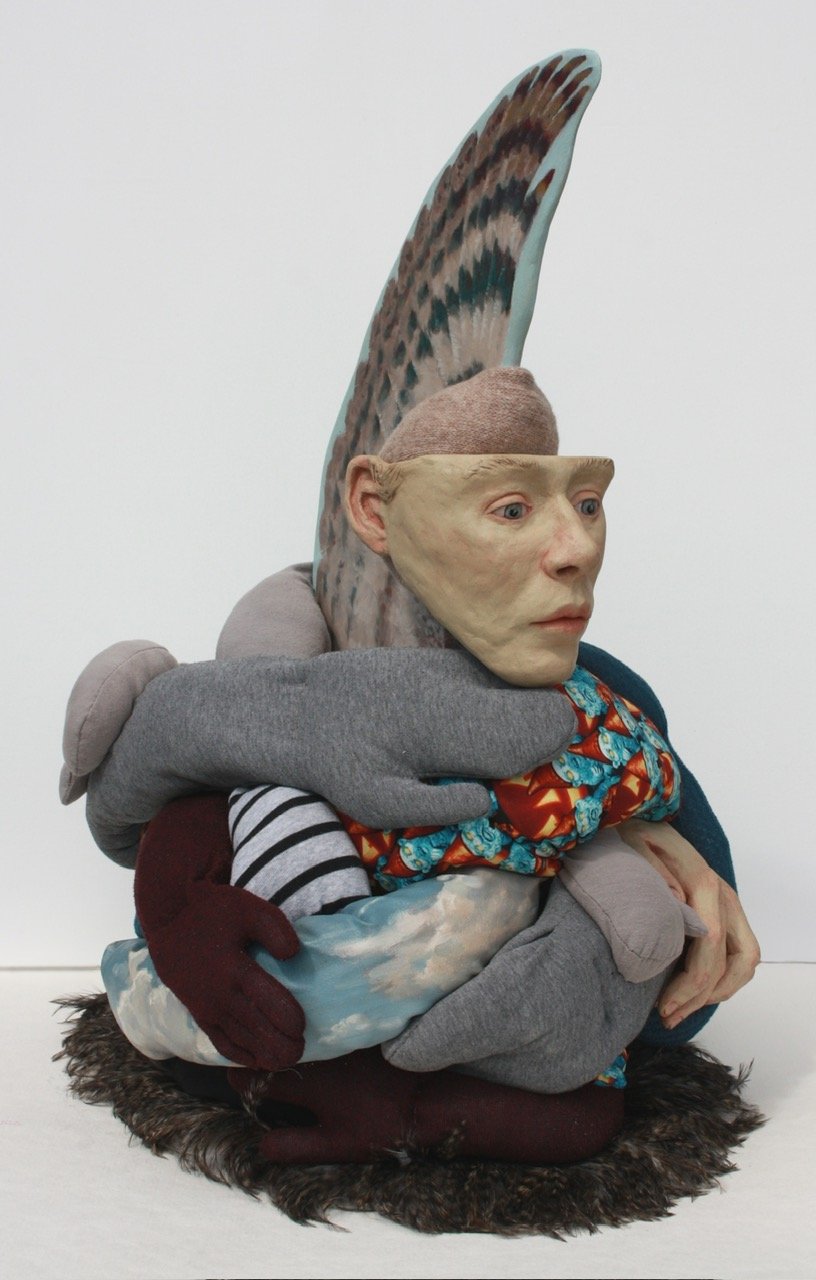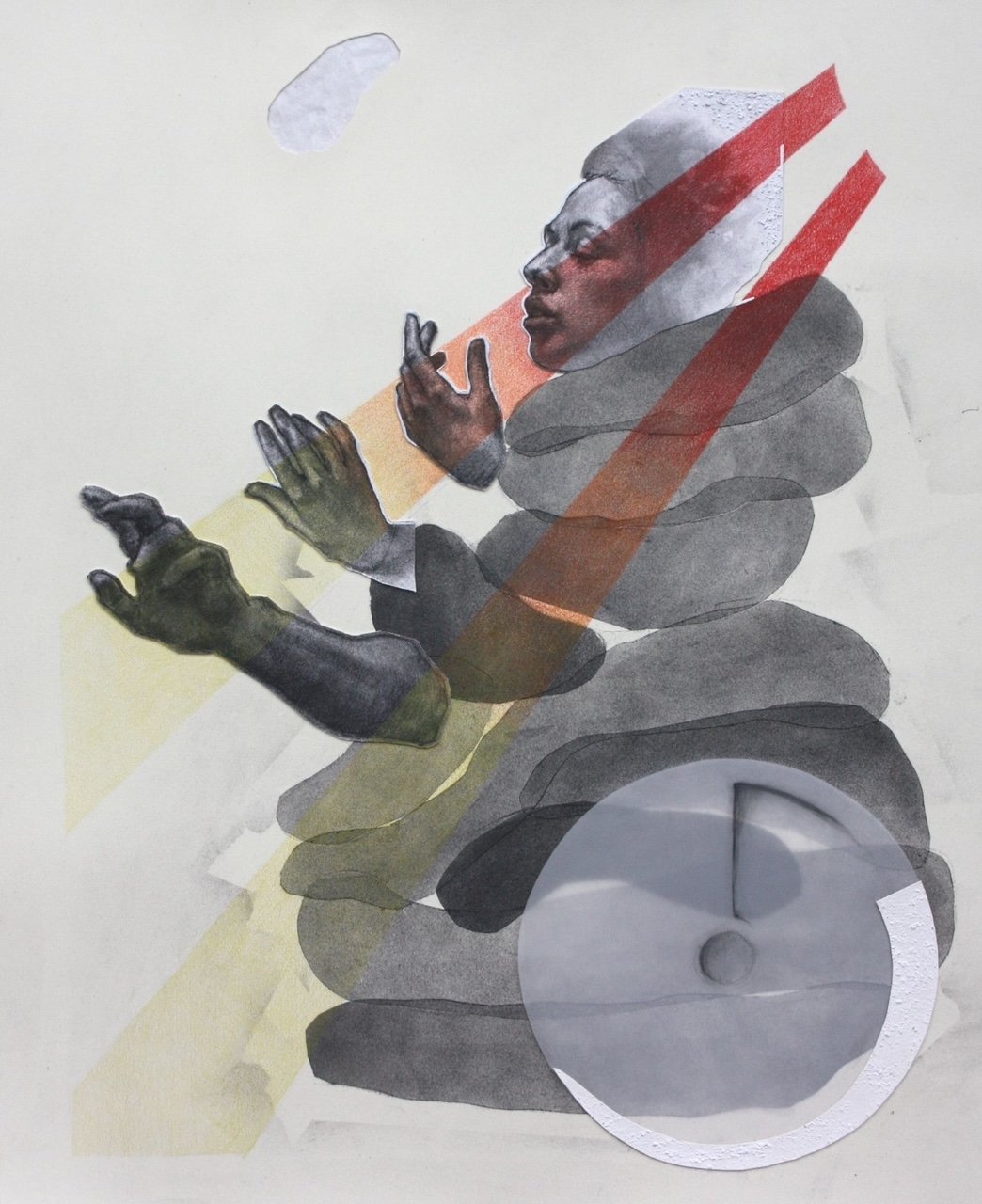Amy J. Dyck: Healing & Adapting
Wheels and Wings, reclaimed fabric on wood with oil paint and fabric paint, 19" x 31"x 2.5"
Artist Amy J. Dyck
Installation view
Neon, mixed media collage with acrylic, charcoal, photograph, 8.5 x 11 inches
Reaching Back, mixed media collage with photograph, pastel, acrylic, ink, paper towel, plastic, 8.5 x 11 inches.
Wing Head, Reclaimed fabrics, oil paint on canvas and wood, reclaimed feather duster, ceramic sculpture, 26” x 19” x 15”
Rough Edges (Dichotomy 21), inkjet photograph, prepared sandpaper, gouache, pencil crayon on card stock, 8.5 x 11 inches.
Red, charcoal and pencil crayon with mixed media on paper, 16 x 20 inches.
Horns, Charcoal with conte and mixed media on mounted paper, 17 x 20 inches.
Website: https://amyjdyck.com/
Instagram: @amyjdyckartist
Based in British Columbia, Canada, Amy J. Dyck’s work is a unique mix of representational and playful expressionism and strives to express the human experience. Using collage, oil paints, and, sculpture, and pulling from anatomical studies, Amy’s work is strongly autobiographical in nature, referencing her journey toward acceptance, resistance, and resilience in the midst of suffering.
How did your creative journey begin?
Like many of us, I fell in love with art at a young age and made it a lot. As a teenager, I handed in a lot of extra work for bonus marks and my art teacher asked me if I wanted to be an artist when I grew up. I told her I thought I’d be too bored as an artist. Now I know that’s because I wasn’t challenged or inspired, and had no idea how powerful or meaningful an art practice could be yet. 16 years ago I gave birth to my son. Babies have a way of taking up all your time and energy. And so I often say that my art practice was born with my son, because that is when I realized how badly I needed it and I finally started fighting to make it happen.
Where do you find inspiration for your work?
My work is birthed out of my own phychological experiences, my feelings, fears, my wrestling with a body that doesn’t behave as bodies are supposed to (such as walking when I want it to). But the work isn’t just about that, I’m really inspired by the ways we find strength and resilience, especially when things are stacked against us, so I use my work to explore the complex ways we fight and adapt and heal. I’m also inspired by expressionistic work that sacrifices aspects of realism in service to the overall feeling of the work. I love the figure, so I pull that in whenever I can, but I get bored when it becomes too predictable for me, so I repeat parts of the figure, repeat patterns and shapes, and lean into a sense of playfulness. Play has been a significant coping strategy for me over the years when dealing with hard thigns. I find that it helps us sit with hard things so I pull it into my art process and let it emerge in the final works themselves. If it makes me smile mischievously, I’m onto something.
How has your work evolved over the last few years?
Initially I spent most of my energy trying to make things look like things, like bodies, portraits, landscapes, objects, etc. This was fun for a while as I got better, but I realized as I went along that it wasn’t just about copying what I saw for me. What called to me was something deeper, a need to express myself, to process and understand myself and the world, to explore. Seven years ago when I got very sick (and ended up in a wheelchair), I had been painting mostly realistic oil paintings of figures. I decided it was time to dig deep and find a way to express the feelings I was holding in my body, my grief, and loss, the fear and confusion, what it felt like to loose mobility and have to be supported by others. During that time I was introduced to collage by a mentor who also prodded me away from realism and challenged me to explore and feel my way through. This changed my entire art practice. Now I approach my work form a place of curiously and play, following my intuitive voice first instead of an intellectual plan.
For a while I was making work what it felt like to live in a broken body, now my work is focussed on the complexity and layers that make up the whole of who we are, and how we find our own resilience and strength in the mix. I reference animal and monster parts, insect and machine, ghosts and abstract forms in an effort to express this complexity and the roles that each of these parts of us take on.
What does a typical day in the studio look like for you, and how has your art practice grown or changed?
This is tricky. My art practice is a fluid thing. The only consistent aspect of it is my commitment to dip into my practice every day when I can. Because I have a family, and also live with Complex Chronic illness, my life can be less predictable. I have two studio spaces, one in my yard with most of my supplies, and one here in my bed. I switch between those spaces as needed, resting when I must. I find I think the clearest in the morning, so I typically get up at 6:30 to deal with any admin work, emails, show applications, etc until its time to drop the kids off at school. The rest of the day until pick up is mine to create, plan, write, or rest, as needed. I used to show up in my studio religiously whether I wanted to or not, and that commitment got me a long way. But my learning these past years is about self-kindness and accepting my own limits, this means that, for me, forcing myself into my studio every day is now counterproductive and damaging. So, instead, I broaden my definition of what it means to make art, to sketching, planning, writing, video editing, learning drawing apps, hand stitching soft sculptures in bed, and just dip into my practice every day.
Which experiences have impacted your work as an artist?
Even just the simple act of having children forces you to fight for the things you want in your life, because kids can take over everything. Getting sick impacted my work significantly, it constantly changes the way I make work as I have to adapt it to my physical needs, this means less large paintings, more smaller drawings or soft sculptures,e tc. My partner has impacted my work too because he is chronically supportive, building me bed-desks and cradled boards and studio walls and anything I could need to create the work. Having a strong ally can be everything. Also, therapy impacts my works, as I process my feelings they begin to emerge in new ways through my collages and sculptures and paintings.
How has social media impacted your work?
Social media has sometimes been a beautiful way to connect to people I wouldn’t normally get to, I love finding my people on there. Sometimes I’ve sold through platforms, sometimes people find me and then come to my shows. Sometimes people reach out to tell me how much my work has meant to them, or how inspired they are - which is always a gift. Social media can be a distraction for me, I can sometimes get swept up in comparing and jealousy, so I try to pull back when this happens. Lately I’ve been using to tell the story around my work as I prepare for two Vancouver exhibits this year. I’ve found these video logs to be meaningful and people have been connecting to the story and coming along with me!
Your work very complex and surreal. How do you come up with your imagery?
It’s funny, I never even considered it to be surreal until people started calling it that. I can certainly see where they are coming from. Usually my work starts with photos of my body, since they are all essentially some version of a self portrait. After a photo shoot, print out hands and legs and faces and torsos, then show up at my collage table with art supplies, papers, and magazines. My intention is to create figures that feel complex and layered but also complete and dignified in their own way. I might tap into a feeling or see what I am drawn to, or have a challenge to use a certain colour, then I see what emerges and feels the most true as I go. This might mean a bird wing is added, or a scorpion tail, it it might mean parts are fighting amongst themselves, or that there are five arms instead of two. I am really interested in the shadow parts of us, those we bury or hide because they aren’t acceptable. But they are a significant part of who we are, so you’ll see darker things like ghosts and monsters emerge, as well as uglier things like lizards and blobs. I play and explore and ask questions and see what happens. Most of my practice is based around these 8.5”x11” collages from photos, magazines, paints, and random extras as they then become sculptures and drawings and larger paintings down the line.

